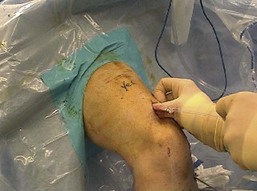Chapter 44 Anterior Cruciate Ligament Reconstruction With Central Quadriceps Free Tendon Graft
Since the introduction of the central quadriceps free tendon (CQFT) graft as an alternative for ACL reconstruction,1 long-term results of this procedure have been reviewed by DeAngelis2 and Geib.3 Results were comparable to both hamstring and bone tendon bone anterior cruciate ligament (ACL) reconstruction and to reconstructions with central quadriceps using bone from the patella. The primary benefit of central quadriceps free tendon is that no bone is harvested from the patella, thereby minimizing the risk of fracture. Rehabilitation is rapid,4 pain medication requirements are less than for other autograft alternatives, and postoperative problems, particularly anterior knee pain, are less common. Central quadriceps as a free tendon graft therefore is a desirable, readily available, low-morbidity autograft alternative for ACL reconstruction.
Technique
After establishing that ACL reconstruction is necessary, the CQFT graft is harvested through a short longitudinal incision immediately above the center of the patella. The central quadriceps tendon is about 9 mm thick, almost twice as thick as the patellar tendon, so a graft measuring 7 mm in depth by 9 to 10 mm wide by 7 cm long is consistently possible to be used. After defining the entire quadriceps tendon above the patella, a 9- to 10-mm-wide graft is delineated centrally, leaning somewhat toward the medial side of the quadriceps tendon where the quad tendon is thickest. Using a no. 10 scalpel blade, medial and lateral borders of the graft are defined, cutting to a 7-mm depth (the depth of a no. 10 scalpel blade). A hemostat is then used to define the posterior border of the graft, leaving about 1 mm of quadriceps tendon posteriorly as a border in front of the suprapatellar pouch. The graft then has portions of both rectus and intermedius components of the quadriceps tendon. The hemostat is spread to define the posterior border of the graft and the free tendon autograft is released from the proximal pole of the patella. Using a uterine T clamp to hold the distal end of the tendon graft, it is dissected sharply and bluntly from distal to proximal, preserving all fibers of the quadriceps tendon. At any point during this procedure, whipstitches may be placed in the end of the graft to hold it better. I use two no. 5 sutures at each end. The graft is dissected bluntly and sharply to a distance 7 cm from the proximal patella (Fig. 44-1) and then released at a 7-cm length after which no. 5 whipstitches are placed at the proximal end. At this point, there are two sets of no. 5 sutures (four strands) coming off each end of the graft, and the graft is marked at the levels desired so that at least 2 cm of CQFT graft will be in each socket (Fig. 44-2).
Stay updated, free articles. Join our Telegram channel

Full access? Get Clinical Tree









